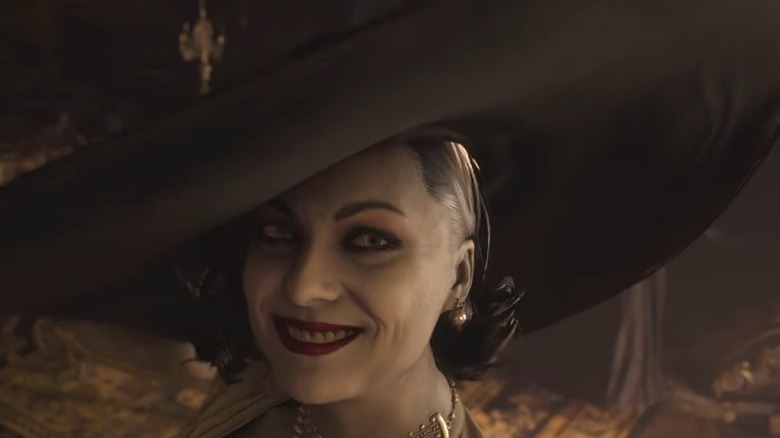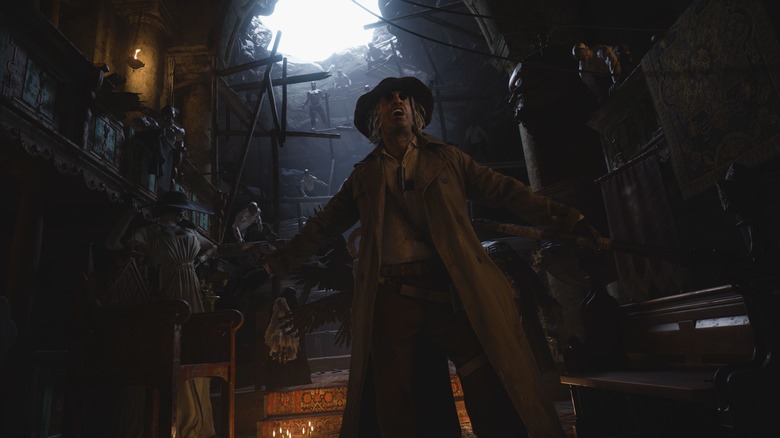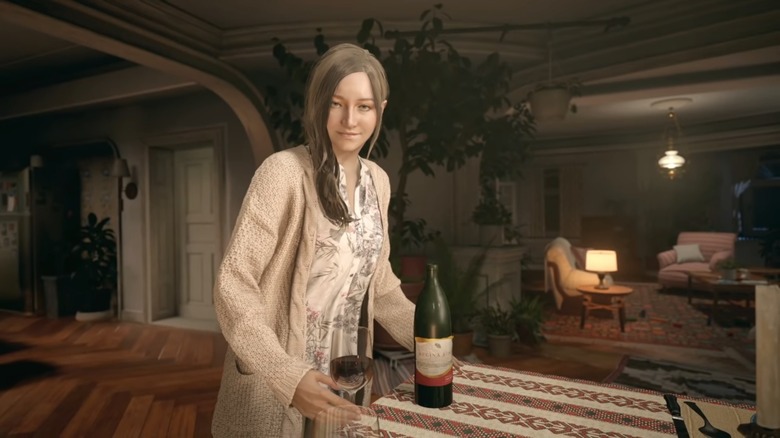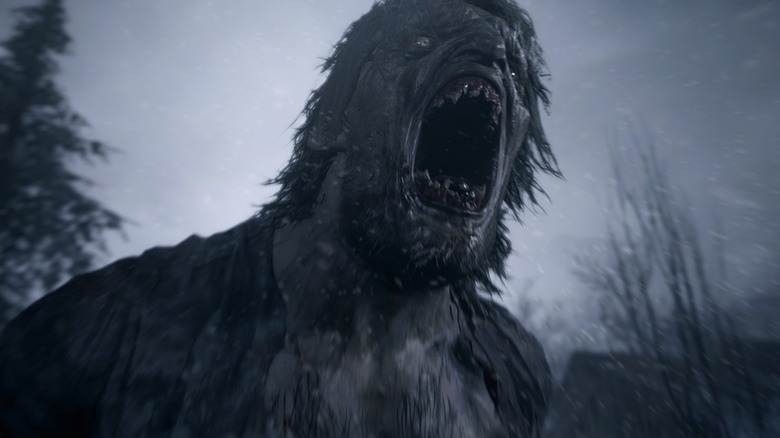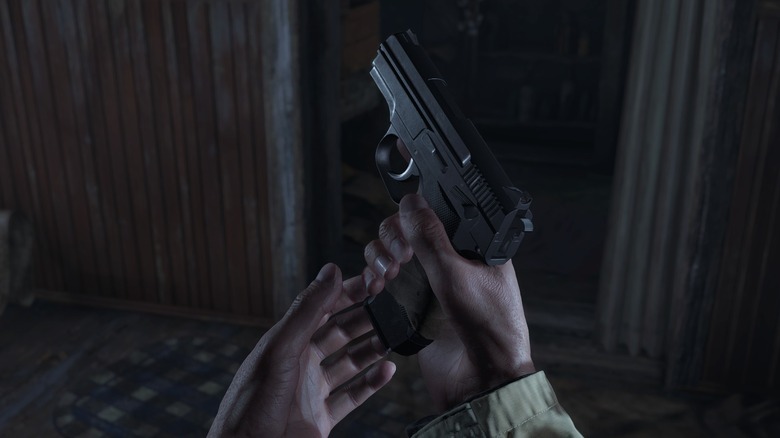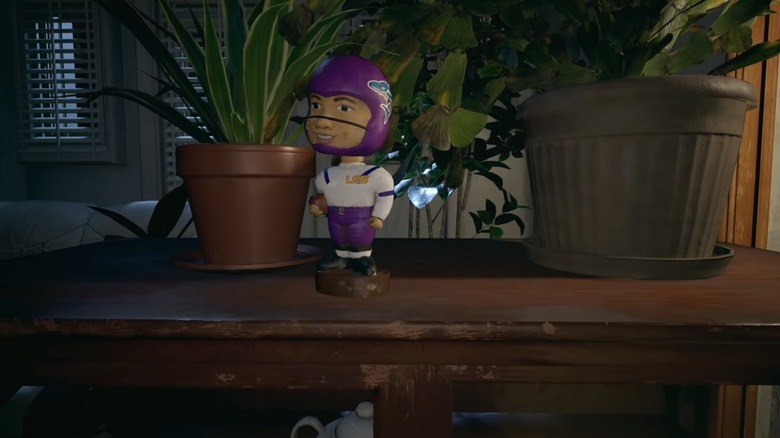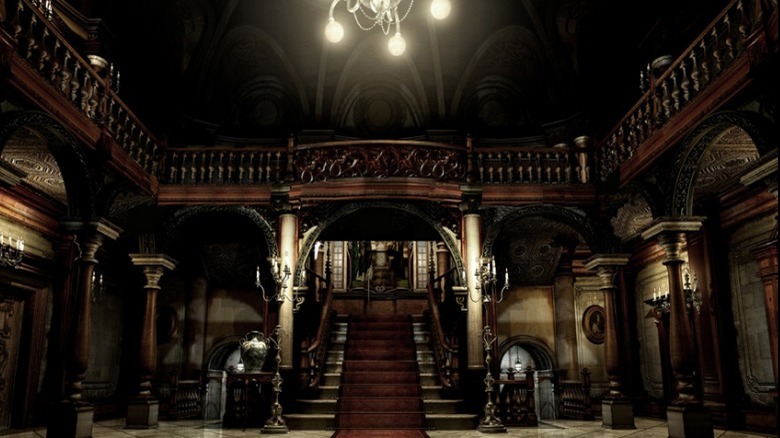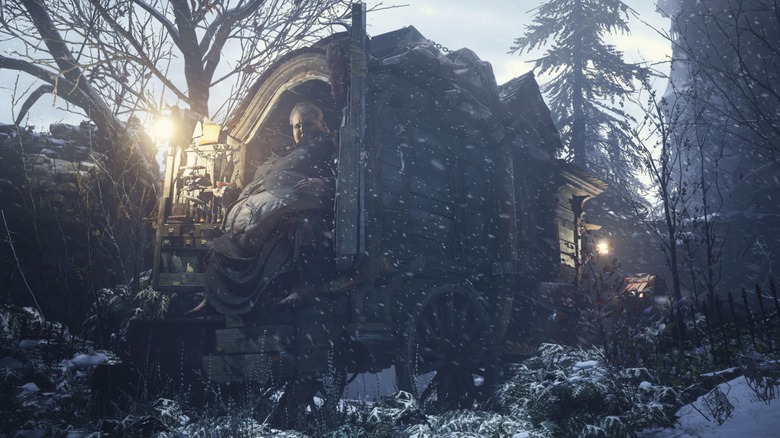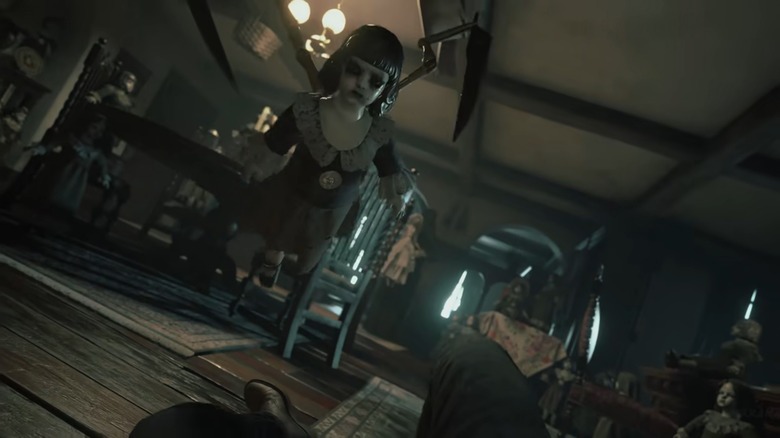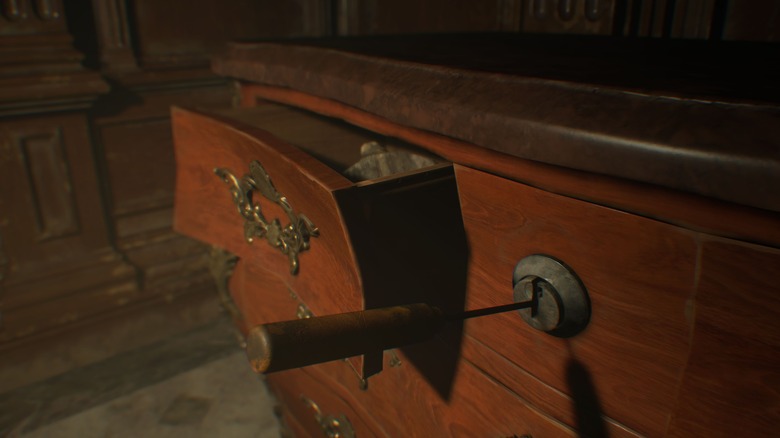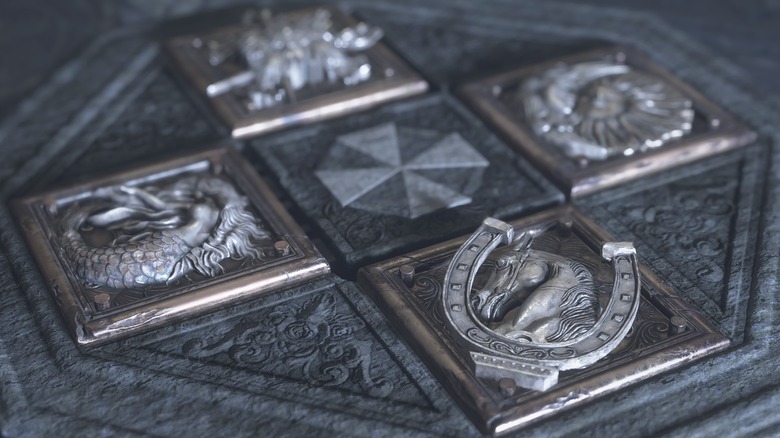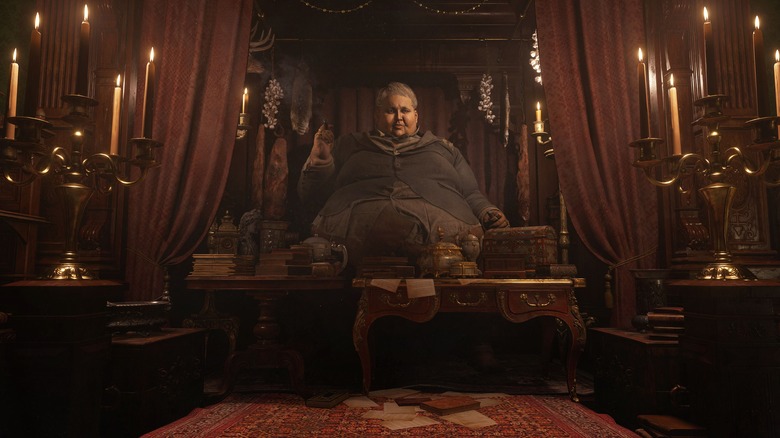Small Details You Missed In Resident Evil Village
As the arguable king of survival horror franchises, "Resident Evil" has a lot weighing on its shoulders. In order to maintain its crown, each entry needs to follow a strict set of rules and exude a level of polish and quality. Sure, the franchise has occasionally stumbled every now and then, but it has found its footing again with "Resident Evil 7," and most recently with "Resident Evil Village."
After the critical success of "RE 7," "Village" had its work cut out for it, and judging by critical reviews, the game passed every hurdle with the grace of an Olympic athlete. Not only does "Village" deliver a terrifyingly good (if slightly less terrifying) experience, it also includes quite a few tiny details that help lighten the mood even more.
Some of these small features tweak immersion ever so slightly, while others are cute little references to events that came before and make a game full of vampires and werewolves feel connected to the wider "Resident Evil" world of zombies and humanoid leeches.
Warning: This article contains massive spoilers for "Resident Evil Village."
Quote references to the past
At first, the recent "Resident Evil" games were divorced from the larger series canon. That illusion was shattered when Chris Redfield tossed Ethan Winters an assault rifle at the end of "Resident Evil 7." Since Chris is a narrative impetus behind "Resident Evil Village," the game drops all pretense and directly references previous games' events and characters through cheeky quotes.
The first quote comes from the game's dedicated gun runner, The Duke. Even though "Resident Evil Village" is a direct sequel to "Resident Evil 7," "Village" shares a lot of DNA with "Resident Evil 4," as both games involve old European villages and castles, cults, and merchants.
At first, The Duke from 'Village" seems like a larger clone of the Weapons Merchant from "RE4." Every so often though, The Duke will initiate a transaction by uttering, "What're ya buyin?" Not only does he mimic the Merchant's unmistakable accent, but The Duke also explains he was quoting "an old friend," indicating a shared history between characters.
Another quote lurks later in the game, when you fight a heavily mutated Karl Heisenberg. Partway through the battle, Chris Redfield blows up Karl's factory, who responds by saying he will "murder that boulder-punching a***hole." This statement clearly references the final battle of "Resident Evil 5," in which Chris punches a boulder to drown Albert Wesker in lava. Chris' face might have changed a bit, but his history sure hasn't.
Red queen wine
The vampiric Dimitrescu family has served as the face of "Resident Evil Village" marketing and memes since the game was announced. Players even got to explore a portion of the Dimitrescu home in the limited-time "Maiden" demo and learned that the family amassed a fortune through wine spiced with the blood of innocent victims. That wine is not only an important bit of backstory, it is also a potentially multi-tiered reference.
If you examined wine bottles during the "Maiden" demo, you might have noticed they bear the name "Regina Rosie." On one hand, as some fans have pointed out, "Regina Rosie" when translated from Romanian to English means "Red Queen," which was the designation of the supercomputer from the "Resident Evil" movies. However, this is only one possible allusion. Regina, when taken literally, is also the name of the red-haired "Dino Crisis" protagonist that Capcom loves to reference but never resurrects.
Terrifyingly, Regina Rosie-brand wine shows up in more than just the Dimitrescu castle. At the start of "Resident Evil Village," Ethan and Mia have a ton of wine in their house. If you closely examine the labels, you will realize it is all Regina Rosie wine, which means that when Chris shot Mia full of holes, he unwittingly saved her from drinking blood wine.
The similarities are more than fur-deep
When setting a tone, video games need to make players face the welcoming committee. In past "Resident Evil" games, that honor fell to a zombie munching all by its lonesome, and "Resident Evil 7" went the Nemesis route with evil, immortal hillbillies that stalk you at all times. "Resident Evil Village" made an entire village of werewolves attack audiences, which should feel familiar to long-time "RE" fans.
Whether by design or coincidence, the initial lycan attack in "Village" shares a few elements with the initial Ganado assault in "Resident Evil 4." Both events take place early in the game when you have little in the way of ammo and healing items, and they both force unwilling participants to fend off waves of preternaturally durable townsfolk.
If those similarities aren't enough, these two onslaughts make you contend with more than just bog-standard beginner enemies. During the "RE4" attack, the Ganado are backed up by the legendary Dr. Salvador and his infamous decap-o-matic chainsaw, while the lycans in "Village" are led by an extra-giant monster named Uriaş who wields a meat tenderizer-like hammer.
The final nail in the coincidence coffin is that both events are unwinnable. There are too many enemies and not enough bullets to go around, so players just have to survive an invisible timer in "Village" and "RE4". Intentional or not, there's more than enough details to link the "Village" attack to the Ganado assault in "RE4."
Got a bullet left in the mag? Save the clip
Reloading weapons in video games makes absolutely no sense. If you have 60 bullets in reserve, fire one, and toss away the clip, you should have 50 left, but in video games, you are magically left with 59. That's video game logic for ya, but "Resident Evil Village" tries its best to mitigate that insanity with detailed and realistic reload animations.
If Ethan empties a weapon's clip entirely, he ejects the clip and lets it land wherever, either by carelessly tossing it aside (littering is the least of your worries when being attacked by monsters) or just letting it land on the ground. But, if the clip isn't fully emptied, Ethan carefully pockets it for later use.
Even though "Village" uses an unrealistic crafting system that lets you manufacture bullets by smashing gunpowder together with random bits of junk, this little reload animation detail explains how any video game character could reload an entire clip after firing one bullet and not lose the rest of the clip. Ethan has survived enough encounters to know that in a zombie-infested location, recycling will save more than just the planet.
Remembering previous adventures
While each "Resident Evil" game has a self-contained story, the series tells a meta-narrative of survivors living to tell the tale and learning from their experiences. Each zombie infestation is an extra physical and mental scar for characters such as Leon Kennedy, while Ethan Winters earns a few trophies. Sort of.
At the beginning of "Resident Evil Village," you can wander Ethan's new house and find several notes and trinkets. One item sitting on a shelf is an unpleasant reminder of his horrific time in the Baker Ranch: a Mr. Everywhere bobblehead. These collectibles items were, well, everywhere in "Resident Evil 7," and if you found and destroyed all 20, you were rewarded with an achievement and unlockable item. When interacting with the bobblehead in his house, Ethan remarks he doesn't know why he keeps it around.
Much, much later in "Village," after you defeat Salvatore Moreau and obtain the crank, you can lower a bridge and do a bit of exploring. In a cave only accessible by boat, you will find a treasure trove of items, including a shotgun attachment and, curiously, an Antique Coin. What is a coin that used to litter the Baker Ranch doing all the way out in Romania? Whatever the reason, once you find it, you can sell it to The Duke for a sizable payout.
Books written by Resident Evil history
Even though video games, movies, and tv shows are insanely popular, there will always be room for the written word. In fact, many video games feature references and gags in the form of in-universe book titles and stories. "Resident Evil Village," for instance, includes several books that reference characters crucial to the lore of "Resident Evil."
If you take time to explore Ethan's home at the beginning of "Village," you will find two books written by characters that players have heard of but never seen before. The first manual is "Gun Survivalist: A Heavy Firearms Manual for Field Combat Situations." Sounds like a must-read for anyone who has encountered zombies, and its author should sound familiar to longtime fans. The book was written by Joseph Kendo, brother of Kendo Gun Shop owner Robert Kendo. Not only is Joseph an accomplished author, he also developed numerous firearms throughout "Resident Evil" history, including Leon Kennedy's Silver Ghost pistol and the recurring Beretta 92F Custom, better known as the Samurai Edge.
Another hidden book in the Ethan residence is "A Historical look into the Architecture of Eastern European Castles and Keeps," which was written by the architect of the infamous Spencer Mansion, George Trevor. Given the puzzles and traps Ethan encounters in the various castles of "Village," it's pretty obvious where George drew inspiration when building the Umbrella-backed estate and its insane halls.
The Duke loves his Romanian recipes
What kind of food does The Duke like? Early concept art depicts him as being surrounded by raw meats of every kind, but as the character's design was refined, so were his tastes. The Duke was given a palate that reflected his title, and his favorite meals were drawn from the country where "Resident Evil Village" takes place: Romania.
In "Village," The Duke offers several services, including buying and selling items, upgrading weapons, and cooking. If you bring him specific ingredients, he will create dishes that permanently increase Ethan's stats. What you may not know is that many of his offerings are based on actual traditional Romanian recipes, including Tochitura de Pui and Sarmale de Peste.
Granted, much like the general crafting system, the recipes are gross oversimplifications. For example, The Duke only asks for "Poultry," "Meat," and "Juicy Game" when cooking Tochitura de Pui. He doesn't even request that you remove the bullets from the ingredients. If you want a genuine Tochitura meal, you will need properly prepared foodstuffs such as pork, sausage, chicken livers, mushrooms, tomatoes, rosemary, and paprika. Perhaps The Duke keeps those items stored in the back?
Return of the Hookman demo dolls
You don't need to look far to find "Resident Evil 4"-shaped fingerprints in "Resident Evil Village." However, most of these telltale signs spring from the publicly released version of "RE4," which doesn't represent the game in its entirety. One event in "Village" potentially references the most famous version of "RE4" that never came to be.
One of the four family heads that must be conquered in "Village" is Donna Beneviento. Unlike other boss fights, which require you to unload a truckload of bullets into giant, mutated monsters, the battle with Donna comes down to a game of hide and seek (and stab) with her favorite doll, Angie. Throughout the fight, Ethan is menaced by animated dolls, which are just parasites wearing porcelain shells — sort of like the Armadura from "RE4." That isn't the reference to look for, though.
The entire scenario of wandering a house infested with dolls brandishing knives is eerily similar to an old "Resident Evil 4" demo known as the "Hookman demo." In that gameplay sample, Leon Kennedy explores an actual haunted house and fights off killer dolls and a ghost wielding hooks, hence the demo's nickname.
While a few of that demo's features survived into the final version of "RE4," such as Leon and animated suits of armor (they became the Armadura), others elements like the dolls were scrapped. At least, until the Beneviento fight.
Don't ignore the map's features
Since "Resident Evil Village" is a survival horror game, you will need every item you can scrounge to get by. It doesn't matter if you want bullets for shooting, herbs for crafting, or trinkets for selling; you need to open every cabinet and examine every crevice you can for resources. Thankfully, the game has a built-in feature that tells you when a particular resource well is all tapped out.
To help Ethan navigate the village and surrounding castles, you can use a built-in map function that automatically keeps track of where you have been and where you have to go. But most important of all, the map magically knows if you missed an item in any given room or building. It doesn't matter if you forgot to smash a vase or shoot a ceiling cache; the map knows all.
The game's magical map usefulness doesn't end there, though. The system also includes a handy tool that tells you if secret passages, puzzles, or other important locations requiring a key are in the vicinity. If you pick up a crucial item during your journey, check the map and see if there are any locked doors. You never know what your new key can open.
Umbrella was inspired by Mother Miranda
Before "Resident Evil Village" was released, trailers hinted at the game's story, and one recurring image proved more mysterious than others: a pedestal decorated with the Umbrella Corporation's logo. What did this mean? Was Umbrella responsible for the recent goings-on in the game's village? Thanks to a late-game (and potentially missable) spoiler, gamers have learned the exact opposite was true.
When you switch perspectives from Ethan Winters to Chris Redfield, you can enter the secret lab of Mother Miranda, who serves as the main antagonist of "Resident Evil Village" (sorry, Alcina Dimitrescu fans). In the lab, you can find pictures and notes that don't exactly rewrite the history of "Resident Evil," but instead shed a new contextual light on it.
These notes and pictures explain that the founder of Umbrella, Oswell Spencer, served as a student of Mother Miranda. Everything that Spencer and his organization have thrown at players since the first "RE" game, from zombie viruses to super soldier clones, he learned from Miranda.
And the icing on the cake? The "Umbrella symbol" on the pedestal also originated in the village. In other words, Spencer plagiarized the village's crest when he created Umbrella, not the other way around. That's one way to tie all of the games together.
Return to Safe Haven with the Mercenary Mode
"Resident Evil" likes to recycle certain ideas. This usually isn't due to laziness, just worldbuilding. After all, when developers want to create a consistent world, it's a good idea to make certain enemies and weapons, like zombies and the Samurai Edge, respectively, into recurring elements. Of course, not all of these repeating ideas are diegetic. Sometimes, Capcom likes to produce a feeling of nostalgia by reusing music tracks. Well, the good ones anyway — nobody wants a remix of "Mansion Basement."
If you go through the main "Resident Evil Village" campaign, you probably won't hear any music you recognize, but the returning Mercenaries mode holds a secret. While you catch your breath and stock up on supplies between missions in The Duke's room, if you take your time outside of his store menu, you will hear a haunting melody that might not mean anything to franchise newcomers. But, if you have been with "Resident Evil" for a while, you will most likely recognize it as a remix of "Safe Haven," the save room theme from the first "Resident Evil."
It's not every day that a "Resident Evil" title reuses old music, but it's fitting that "Village" rekindles feelings of safety in the one location where the game's enemies can't follow, and does so with a retread of a familiar track. Few things calm the nerves quite like some relaxing tunes.

